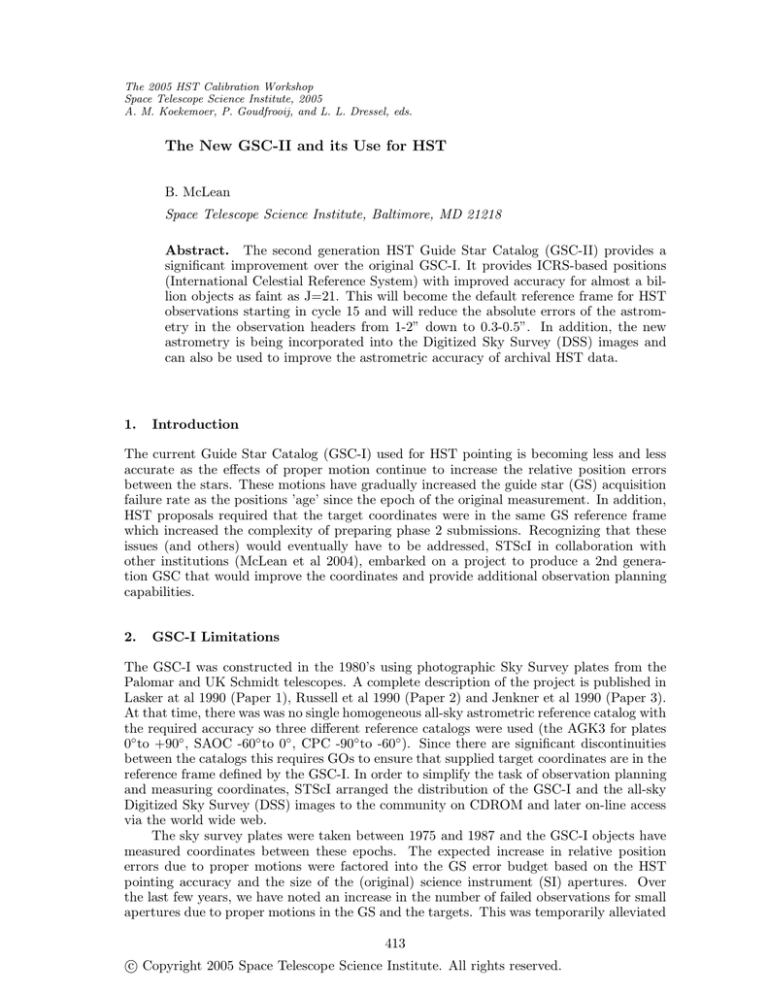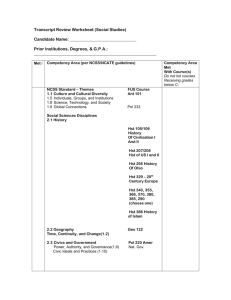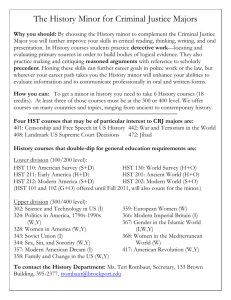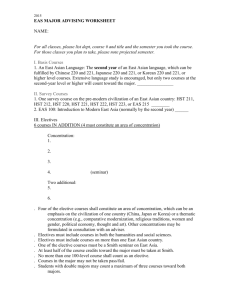
The 2005 HST Calibration Workshop
Space Telescope Science Institute, 2005
A. M. Koekemoer, P. Goudfrooij, and L. L. Dressel, eds.
The New GSC-II and its Use for HST
B. McLean
Space Telescope Science Institute, Baltimore, MD 21218
Abstract. The second generation HST Guide Star Catalog (GSC-II) provides a
significant improvement over the original GSC-I. It provides ICRS-based positions
(International Celestial Reference System) with improved accuracy for almost a billion objects as faint as J=21. This will become the default reference frame for HST
observations starting in cycle 15 and will reduce the absolute errors of the astrometry in the observation headers from 1-2” down to 0.3-0.5”. In addition, the new
astrometry is being incorporated into the Digitized Sky Survey (DSS) images and
can also be used to improve the astrometric accuracy of archival HST data.
1.
Introduction
The current Guide Star Catalog (GSC-I) used for HST pointing is becoming less and less
accurate as the effects of proper motion continue to increase the relative position errors
between the stars. These motions have gradually increased the guide star (GS) acquisition
failure rate as the positions ’age’ since the epoch of the original measurement. In addition,
HST proposals required that the target coordinates were in the same GS reference frame
which increased the complexity of preparing phase 2 submissions. Recognizing that these
issues (and others) would eventually have to be addressed, STScI in collaboration with
other institutions (McLean et al 2004), embarked on a project to produce a 2nd generation GSC that would improve the coordinates and provide additional observation planning
capabilities.
2.
GSC-I Limitations
The GSC-I was constructed in the 1980’s using photographic Sky Survey plates from the
Palomar and UK Schmidt telescopes. A complete description of the project is published in
Lasker at al 1990 (Paper 1), Russell et al 1990 (Paper 2) and Jenkner et al 1990 (Paper 3).
At that time, there was was no single homogeneous all-sky astrometric reference catalog with
the required accuracy so three different reference catalogs were used (the AGK3 for plates
0◦ to +90◦ , SAOC -60◦ to 0◦ , CPC -90◦ to -60◦ ). Since there are significant discontinuities
between the catalogs this requires GOs to ensure that supplied target coordinates are in the
reference frame defined by the GSC-I. In order to simplify the task of observation planning
and measuring coordinates, STScI arranged the distribution of the GSC-I and the all-sky
Digitized Sky Survey (DSS) images to the community on CDROM and later on-line access
via the world wide web.
The sky survey plates were taken between 1975 and 1987 and the GSC-I objects have
measured coordinates between these epochs. The expected increase in relative position
errors due to proper motions were factored into the GS error budget based on the HST
pointing accuracy and the size of the (original) science instrument (SI) apertures. Over
the last few years, we have noted an increase in the number of failed observations for small
apertures due to proper motions in the GS and the targets. This was temporarily alleviated
413
c Copyright 2005 Space Telescope Science Institute. All rights reserved.
414
McLean
when STIS failed (since there was no longer an SI with a small aperture), however if COS
is installed in a future servicing mission then we would be unable to meet the requirements
for placing targets in its small apertures.
The GSC-I was originally designed to have GS in the range 9-15 over the entire sky
that could be used by the FGS to point HST. This was to efficiently select GS in a highly
automated way. Once STIS (and later ACS) was selected as a replacement instrument, it
was recognized that it would be necessary to check the FOV for each pointing to ensure that
no UV-bright star (V ≤ 20m) would be in the aperture of the MAMA detectors. A ’bright’
star would result in detector damage. This became a ’Health and Safety’ issue requiring a
visual inspection of the field using the DSS for each pointing. It was quickly realized that
a deeper object catalog would allow similar efficiency improvements to this ”Bright Object
Protection’ task.
3.
GSC-II Overview
Even though the concept of a second-generation catalog was developed soon after the original GSC-I was completed it took many years to get all the necessary components in place.
The most fundamental item was to scan more recent epoch plates. This was accomplished
by obtaining access to the POSS-II surveys in the northern hemisphere and in collaboration
with the AAO, arranging for a new southern hemisphere survey. The STScI scanning machines were significantly upgraded to complete digitization of all the plates at the required
resolution (Laidler et al 1996). In order to proceed with the construction, digitization and
distribution of the new DSS and the development and production of the GSC-II (McLean et
al 1998), STScI partnered with a large number of institutions to cost-share and distribute
the work in return for early access to the datasets for telescope operations.
One of the early design decisions was to scan and process all the available Palomar
and UKSTU surveys in order to give both multi-passband and multi-epoch observations
to allow the measurement of proper motions and colors of the objects wherever possible.
This provides at least 3 passbands and 2 epochs (including a recent epoch) everywhere on
the sky. The images were processed to the plate limits to get the maximum amount of
information for observation planning. All of these observations are stored in a 3TB objectoriented database (Greene 1998) which is mined to produce an export catalog with the
derived parameters for almost a billion objects.
The availability of homogeneous all-sky astrometric reference catalogs (ACT, TYCHO2) based on the ICRS reference frame was a major factor in the astrometric improvements
along with improved plate modeling and reduction techniques. The result is that GSCII has an absolute astrometric error of 0.25” (1-sigma) over the entire sky. In order to
obtain a photometric calibration fainter than 15th magnitude a major observing campaign
was begun to obtain CCD frames for every survey field to create a network of secondary
reference stars for calibrating the plates. Despite using photographic material we typically
have a photometric error of 0.3mag (1-sigma) and a classification rate (star/non-star) of
95%.
4.
HST Observing
Whilst the fundamental goal of this change is to improve the precision of HST pointing, the
GO will see some simplification of the procedures used to provide target coordinates.
4.1.
Phase 2 Changes
A new keyword (ICRS) has been added to the phase 2 proposal preparation options for
the coordinate reference frame. The existing keywords are still present for cycle 15 whilst
GSC-II
415
this transition takes place, but ICRS is the default selection and recommended whenever
possible. Many of the recent major surveys and catalogs are ICRS-based (2MASS, SDSS,
USNO-B, FIRST etc), so coordinates may be taken directly from these sources without
transferring them into the GSC reference frame.
4.2.
Measuring DSS Images
If your target is an extended non-stellar source such that it’s catalogued coordinate in
GSC-II (or any other catalogue) is not where you wish to place the SI aperture, and yet
is bright enough to appear on the DSS images you can measure the coordinates as before.
The GSC-II coordinates are primarily based on the IIIaF (red) surveys. This is the most
recent epoch so we strongly recommend using these images to minimize the errors. The
DSS images headers have also been updated to include the ICRS astrometry. Whilst the
old GSC-I calibration keywords are still in the headers (for backward compatibility), a new
set of GSC-II calibration keywords and FITS extensions are also included. This calibration
however, is a 3-step non-linear transformation that most FITS readers do not yet implement.
To provide the ICRS information we have modified the code running on the DSS server at
STScI to dynamically compute a simple FITS WCS (World Coordinate System) calibration
that all packages should be able to utilize. This uses the local GSC-II solution at the
position of each image extraction to compute the WCS keywords which it then inserts into
the returned FITS image. You can measure the positions using any analysis tool that
utilizes the FITS WCS. Once your measured position is entered into your proposal, please
select the ICRS reference frame option.
4.3.
Measuring CCD images
If your target is not visible directly on the DSS images or otherwise catalogued, you are
expected to provide coordinates by transferring the GSC reference frame to your images
(this includes HST images). Instead of using GSC-I, one can now use the much deeper
GSC-II, or any other ICRS-based catalogue which makes finding reference stars easier.
4.4.
Tools
Access to the GSC-II and DSS images will be built into the cycle 15 release of the Astronomers Proposal Tool (APT) which provides a convenient interface using the Visual
Target Tuner (VTT). Alternatively, one will be able to find links to web forms available
from the STScI website. If a GO has successfully observed a target with HST in a previous
cycle and is confident that the target has zero proper motion, we also provide a web form
that can convert your GSC-I based coordinate to the GSC-II ICRS coordinate. This tool
measures the average coordinate shift for the GSC-I objects over the HST field of view and
corrects the supplied coordinate accordingly.
5.
Status
At the time of submitting this manuscript, HST has successfully used the GSC-II for a first
on-orbit test. Assuming that the remaining tests are successful, then the ICRS/GSC-II will
become the default reference system for HST observing in cycle 15 and beyond.
We have successfully completed a feasibility study (Koekemoer et al 2005) of using the
GSC-II to recalibrate HST ACS images, and looking ahead, STScI is considering a project to
do this for as many images in the HST archive as possible. This would significantly improve
the scientific usefulness of HST images when comparing them to observations at different
wavelengths. In the case of images without sufficient GSC-II stars to recalibrate, then
updating the coordinates using the GSC-I to GSC-II offset will still improve the astrometry
and put it on the standard ICRS.
416
McLean
Even further in the future, it is planned to use the GSC-II (with improvements and
cross-matching to 2MASS for IR magnitudes) as the basis for JWST operations. Studies
have established that it is deep enough to provide sufficient GS (even at near-IR wavelengths) to point JWST.
Acknowledgments. We acknowledge the contributions of our many collaborating institutions. These include: Osservatorio Astronomico di Torino, Space Telescope - European
Coordinating Facility, European Space Agency - Astrophysics Division, European Southern
Observatory, International GEMINI Project, Canadian Astronomical Data Center, Centre
de Donne Stellaire, Anglo-Australian Observatory, Royal Observatory Edinburgh, National
Astronomical Observatory Japan, Beijing Astronomical Observatory, Palomar Observatory
and the Leicester Database and Archive Service.
References
Greene,G., McLean,B., Lasker,B., Wolfe,D., Morbidelli,R. & Volpicelli,A. 1998, IAU Symposium 179, 474
Jenkner,H., Lasker,B.M., Sturch,C.R., McLean,B.J., Shara,M.M. & Russell,J.L. 1990, AJ,
99, 2081
Koekemoer,A.M., McLean,B., McMaster,M. & Jenkner,H. 2006, The 2005 HST Calibration
Workshop. Eds. A. M. Koekemoer, P. Goudfrooij, & L. L. Dressel, this volume, 417
Lasker, B.M., Sturch,C.R., McLean,B.J., Russell,J.L., Jenkner,H. & Shara,M.M. 1990, AJ,
99, 2019
Laidler,V., Sturch,C., Greene,G., Lasker,B.M., McLean,B., White,R., Bucciarelli,B., Lattanzi,M., Spagna,A. & Zacchei,A.2003, in Proc. 2002 HST Calibration Workshop,
ed. S. Arribas, A. Koekemoer, & B. Whitmore (Baltimore: STScI)1996, BAAS, 188,
5421L
McLean,B., Hawkins,G., Spagna,A., Lattanzi,M., Lasker,B., Jenkner,H. & White,R. 1998
IAU Symposium 179, 43
McLean,B., Lattanzi, M., Greene, G., Loomis, C. & Meakes, M. 2004, SpaceOps 2004
conference proceedings
Russell,J.L., Lasker,B.M., McLean,B.J., Sturch,C.R. & Jenkner,H. 1990, AJ, 99 2059








